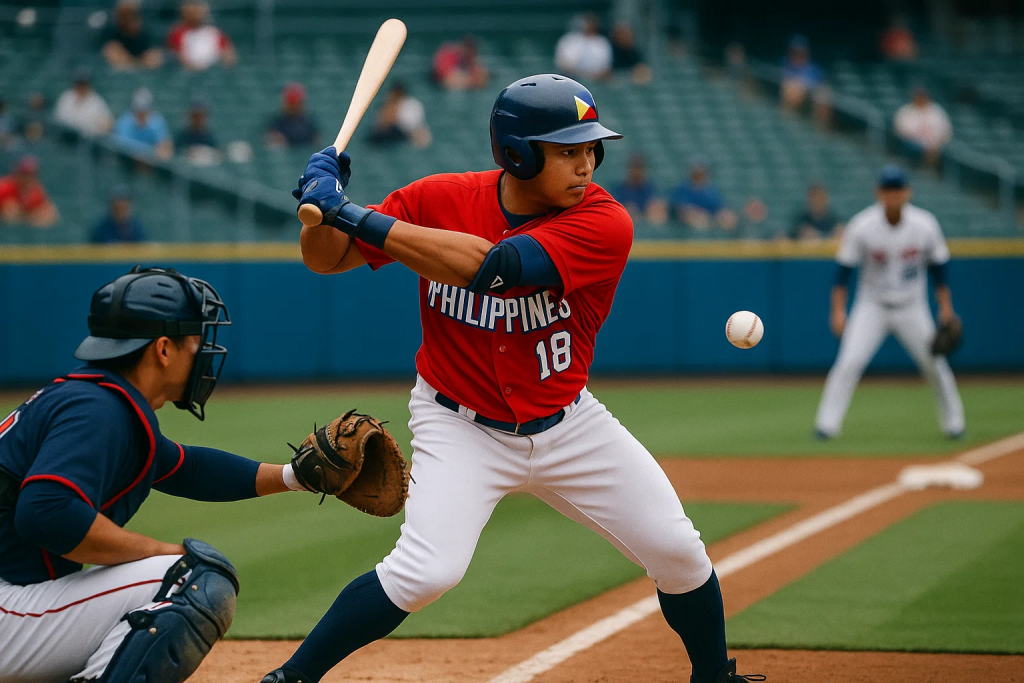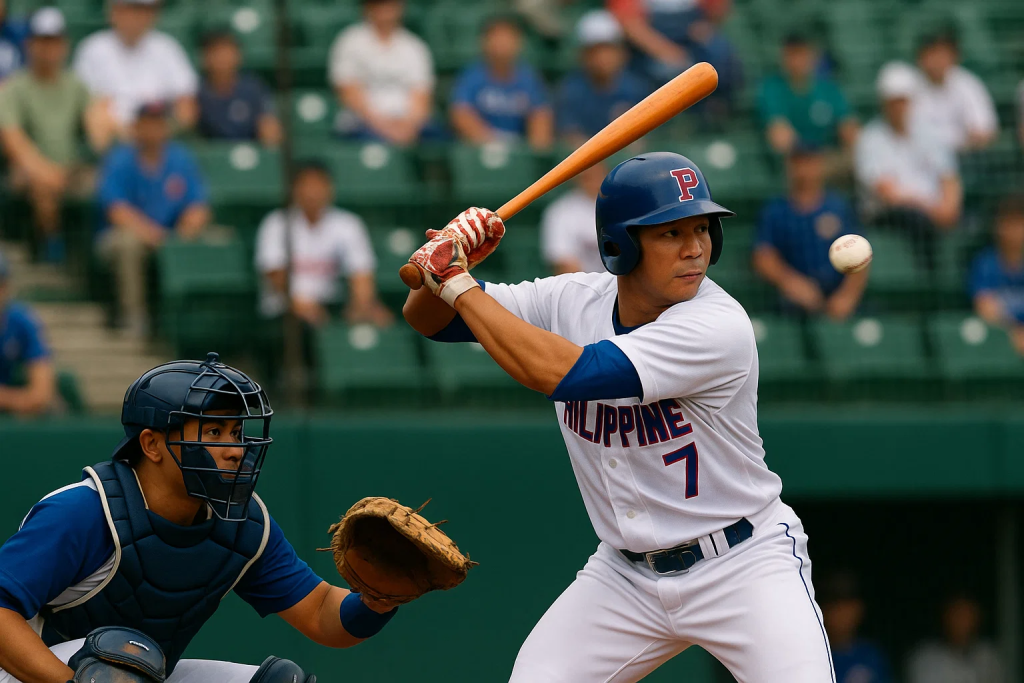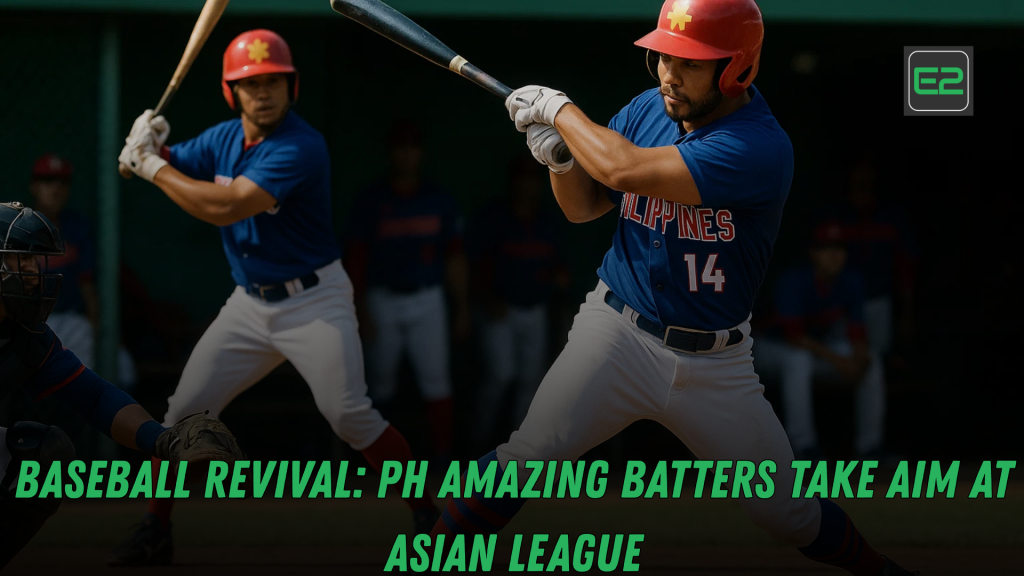Table of Contents
TL;DR
Baseball in the Philippines is quietly staging a comeback. With structured pipelines—from grassroots and school leagues to high-performance training and international placements—PH batters and pitchers can realistically target the NPB (Japan), KBO (Korea), and CPBL (Taiwan) in the next few seasons. This long-form guide lays out a turnkey roadmap for players, coaches, schools, clubs, and brands: facilities standards, program design, talent ID, analytics, funding models, media strategy, and a 12-month action plan. Stick around to grab the plug-and-play checklists and FAQ at the end.

Why Talk About a PH Baseball Revival—Now?
- Geography & market fit. The Philippines sits in a neighborhood where elite baseball is thriving—Japan’s NPB, Korea’s KBO, and Taiwan’s CPBL. Travel times are short, cultures are connected, and calendar windows often align with school breaks—perfect for cross-border camps and tryouts.
- Untapped athlete pool. The country produces fast, explosive multi-sport athletes from basketball, track, and sepak takraw. With proper throwing mechanics, arm care, and swing design, many can be re-skilled for baseball roles (outfielders, middle infielders, relief arms).
- Diaspora & dual-pathway. Filipino heritage players (Phil-Ams, Phil-Aussies, Phil-JPN) add experience from stronger baseball ecosystems and can lift standards while mentoring homegrown prospects.
- Low-barrier on-ramps. Baseball5, blitzball, and rubber-ball variants shrink costs and space needs, letting barangays and schools create high-rep game environments before moving kids into hardball.
Bottom line: The timing is ideal for a coordinated national push—one that begins with schools and clubs, but keeps sight of the Asian pro market.
The Asian League Landscape: What PH Players Must Know
- NPB (Japan): The benchmark in Asia. Emphasis on precision pitching, contact quality, and baseball IQ. Imports face higher bars, but Asian heritage and regional familiarity help.
- KBO (Korea): Offensive output is strong; clubs value contact hitters with plate discipline and pitchers with carry fastballs + quality secondaries.
- CPBL (Taiwan): Outstanding platform for developing imports and Asian prospects; open to regional talent who show real game power or reliable swing-and-miss stuff.
- Independent/Regional circuits: Japan’s independent leagues, Australia’s ABL, and college circuits across Asia supply reps, video, and TrackMan/Rapsodo-grade data to attract scouts.
Fit for PH talent:
- Position players: Middle infielders with range/speed and bat-to-ball skills; corner outfielders with arm strength and carry; catchers with pop times <2.0s and receiving skills.
- Pitchers: Sub-6’0” arms with elite movement profiles can still thrive if they pair a 90+ mph fastball (or metric-equivalent carry) with two above-average secondaries and consistent strike throwing.
What “Revival” Actually Looks Like: A System, Not a Slogan
1) Grassroots to Game-Ready: The Four-Stage Pipeline
- Discovery (Ages 6–12)
- PE modules: throwing pattern basics; Baseball5 stations in covered courts.
- “Try-days” with foam balls/whiffle, short bases, rotating positions.
- Parent sessions on fun + safety first; zero-cut teams to maximize participation.
- Development (12–16)
- Club training 2–3×/week: arm care, hitting foundations (launch position, barrel control), infield/outfield footwork.
- House leagues with pitch counts, rest rules, and certified first-aid/CPR staff.
- Video-assisted feedback; intro to blast sensors or phone-based bat speed measurements.
- Performance (16–20)
- School/UAAP programs and regional clubs using structured S&C (bilateral/unilateral strength, sprint work, decel training).
- Rap/Rapsodo/TrackMan or equivalent sessions quarterly to benchmark velocity, spin, attack angles.
- Games against visiting academies; curated exposure trips to Asia.
- Placement (18+)
- Scouting combines with standardized testing: 60-yard dash, 10-yd split, throwing velo, pop time, bat speed, bat-to-ball, live ABs.
- Video & data packs sent to Asian clubs/agents; visa & academic planning for JUCO/college routes if needed.
2) Facility Blueprint: How to Build “Enough” (Not Excess)
Field alternatives:
- 90-ft diamond is ideal, but do not wait. Mark 70–80% scaled fields at school ovals or open lots.
- Covered courts can host Baseball5/tee work/short toss with portable nets.
- Portable mounds + turf strips convert any open space into a bull-pen lane.
Minimum viable club kit (per 20 players):
- 6–8 bats (youth and -3), 3 catcher sets, 2 tees, 2 pop-up nets, 3 buckets of balls, portable mound, 20 gloves (mix sizes), resistance bands, softballs/whiffle for crowded spaces.
Lighting, safety, med:
- 200–300 lux for night practice.
- First-aid station, AED if possible, and ice + compression gear for acute care.
- Clear foul-ball safety zones and signage.
3) Coaching & Curriculum: From Fun to Measurable Gains
Coach pathway:
- Level 1: PE teachers/parent-coaches—throwing pattern basics, arm care, Baseball5 rules.
- Level 2: Club coaches—hitting/fielding progressions, bullpen planning, game management.
- Level 3: High-performance—pitch design, swing decisions, matchup tactics, return-to-throw protocols.
Weekly practice template (90 minutes):
- 10’ Dynamic warm-up + arm care
- 20’ Hitting stations (tee → front toss → machine/live)
- 15’ Defense (IF/OF splits; footwork + transfers)
- 15’ Throwing development (plyo balls/constraint drills)
- 20’ Situational scrimmage (bunt D, 1st/3rd, pickoffs)
- 10’ Cool-down + notes
Teaching the modern hitter:
- Home base: balanced launch position, eyes level, efficient hand path.
- Feedback loop: ball flight first, then contact quality (EV estimates), then swing metrics.
- Decision training: colored-ball takes, game-speed BP (mix 60% strikes, 40% chase).
Pitching, safely:
- Build capacity before intensity (throwing volume → long toss → plyo → velo days).
- Two “on days,” one “recovery catch” day per week in season; no year-round max-effort.
- Pitch design basics: fastball shape (ride/run), one glove-side breaking ball, one arm-side change/split; attack zones, tunneling.
4) Data Without Breaking the Bank
- Phones + tripods for swing/pitch capture at 120–240 fps.
- In-app or spreadsheet EV estimators using distance and launch angle proxies.
- Shared Google Drive folders per athlete: video, notes, monthly progress.
- Quarterly combine: 60-yd, 10-yd, jumps (CMJ/broad), med-ball throws, grip strength, throwing velo, bat speed.
Why it matters: Asian scouts trust repeatable data. You don’t need a stadium—just consistent testing and clear, legible video.
5) Competitions That Build (Not Break) Development
- House Leagues: 6–8 teams, short games, equal playing time at the Discovery level.
- Club Circuit: weekend doubleheaders, pitch-count enforcement, mercy rules to protect arms.
- Showcase Windows: mid-season and year-end combines with guest coaches from Asia/Australia.
- Baseball5 Festivals: barangay-level events to keep the funnel wide and fun.
Scheduling tip: Align with school calendars; avoid exam weeks; publish season dates 6–9 months in advance.
The High-Performance Layer: Turning Prospects into Pros
Strength & Conditioning (S&C)
- Speed first: 10-yd acceleration, fly-10s, wicket runs; build hip projection and stiffness through the floor.
- Strength staples: trap-bar deadlift, RFESS (rear-foot elevated split squat), chin-ups/rows, landmine press, anti-rotation core.
- Thrower care: scap traction & upward rotation, rotator cuff endurance, soft-tissue hygiene (lats/pecs).
- In-season: micro-doses 2×/week (25–35 min), never to exhaustion pre-game.
Arm Care & Return-to-Throw
- Red-flag triggers: loss of ROM, “dead arm,” persistent tenderness, velo drop >3 mph.
- Step-down protocol: reduce intensity, move to constraint drills and recovery catch, re-progress with volume before intent.
- No overnight jump in pitch counts; use acute:chronic workload tracking (simple 4-week rolling average).

Nutrition & Recovery
- Baseline: 1.6–2.2 g/kg protein for athletes in training blocks; carbs around high-intensity days; electrolytes in heat.
- Hydration checks: morning weight and urine color chart.
- Sleep: 8+ hours; 20–30 min naps between school and evening practice.
Scouting, Representation, and Cross-Border Logistics
Show what scouts actually need:
- 2–3 minute hitter reel: tee/front toss (angles), machine/live vs variety, spray chart overlay if possible, 60-yd, arm strength throws.
- Pitcher reel: 10–15 pitch bullpen, fastball shape and both secondaries, live ABs if available, velo board in frame.
- Data card: age, height/weight, positions, measurables, test dates, coach contacts, passport/visa status.
Agents & clubs:
- Vet agents who have placed athletes in Asia; insist on transparent fee structures.
- For club outreach, package video + data + character references from coaches/teachers.
Education matters:
- Keep academic options open. A JUCO/college stint in Asia-Pacific or North America can mature both body and baseball IQ—and increase placement odds later.
Funding the Revival: How to Make It Sustainable
- Community clubs: membership tiers (development vs performance); scholarship slots funded by sponsors.
- LGU & school partnerships: access to covered courts/fields in exchange for public sessions and Baseball5 festivals.
- Brands (telco, hydration, apparel): on-field utility beats banners—water stations, shade tents, ball buckets, first-aid kits.
- Crowdfunding & alumni: “Adopt a team” drives; transparent ledgers; quarterly impact reports (number of kids, sessions, certifications).
Media & Content: Own the Story
- Pillar pages: “Baseball Philippines,” “How to Join a Baseball Club in [City],” “Asian Scouts: What They Look For.”
- Weekly shorts: hitting tips in Tagalog/English, arm care reminders, tournament highlights.
- Community features: profile a public school player who learned Baseball5 first and moved to hardball, or a coach who finished Level 2.
- Responsible messaging: celebrate effort, process, and team values—not early specialization or burnout.
12-Month Action Plan (Anyone Can Start Here)
Quarter 1 – Lay the Groundwork
- Form a core committee (coaches, PE teachers, a medical lead, and a parent liaison).
- Audit facilities; acquire the minimum viable kit; publish the season calendar.
- Run two Baseball5 try-days; identify prospective coaches for Level 1 training.
Quarter 2 – Launch & Measure
- Start house league; institute pitch counts and arm-care blocks.
- Hold the first combine (speed, arm, bat speed) and capture video for every athlete.
- Schedule one friendly vs a visiting academy; log every plate appearance.
Quarter 3 – Raise the Ceiling
- Coach Level 2 course; introduce S&C micro-dosing at practice.
- Tape measure EV estimates and spray charts; begin individualized swing plans.
- Plan an exposure camp with at least one foreign coach/scout.
Quarter 4 – Showcase & Scale
- Second combine; update reels and data cards; open placement conversations.
- Host a Baseball5 festival + hardball finals day; capture media assets.
- Publish a year-end report: participation, injuries (target: minimal), performance gains, funding use—then recruit sponsors for Year 2.
Common Pitfalls—and How to Avoid Them
- Chasing velocity without capacity. Build throwing volume and tissue tolerance first.
- Over-gaming the schedule. Too many games, not enough practice = stalled skill growth.
- No data continuity. One-off “event” metrics won’t persuade scouts; test quarterly.
- Facility perfectionism. Waiting for a stadium delays progress—start small, iterate.
- Coach burnout. Rotate session leaders, use templates, and celebrate small wins.
What Success Could Look Like (24–36 Months)
- 10–15 schools per metro running Baseball5 PE + club teams, feeding 4–6 regional hardball clubs.
- A national coach pathway that certifies 150+ Level 1/2 coaches.
- Quarterly combines generating clean reels & data for 200–300 prospects.
- 5–10 cross-border placements (college/independent/CPBL developmental) per year.
- A credible, repeatable PH-to-Asia pipeline—and a national team that benefits from year-round, high-quality reps.
Call to Action
Players & parents: Tell me your age, city, primary position(s), and current 60-yard time or throwing/bat speed if you have it. I’ll send a free 8-week skill plan (hitting or pitching), a simple arm-care routine, and a video checklist for your next showcase.
Coaches & schools: Share your space (field/court), weekly time slots, volunteer count, and budget range. I’ll reply with a turnkey program pack: practice templates, combine sheets, minimum kit list, and a sponsorship one-pager to start conversations with local brands.
Clubs & brands: If you’re ready to underwrite a pilot Baseball5 + hardball pathway in your city, I can draft a 12-month rollout (budget, KPIs, media plan) you can bring to your LGU and partners.
Final Word
The article outlines a practical, system-first roadmap for a genuine baseball revival in the Philippines, aimed at moving Filipino players from schoolyards and clubs into Asian professional pathways such as Japan’s NPB, Korea’s KBO, and Taiwan’s CPBL. It argues that geography, cultural ties, and improving connectivity make this a timely opportunity, while the Philippines’ multi-sport athlete base, diaspora talent, and low-cost formats like Baseball5 provide a broad entry funnel.
A clear four-stage pipeline anchors the plan. (1) Discovery (6–12) uses PE modules, Baseball5, foam/whiffle tools, and zero-cut participation to teach safe throwing and basic game sense. (2) Development (12–16) adds club training 2–3×/week with arm care, hitting foundations, and house leagues with pitch counts, plus video feedback. (3) Performance (16–20) layers structured strength & conditioning, quarterly pitch/hit data sessions (TrackMan/Rapsodo or budget alternatives), and scrimmages with visiting academies. (4) Placement (18+) standardizes scouting combines, video reels, and data cards for outreach to Asian clubs, agents, and colleges.
The facility blueprint emphasizes “enough, not excess”: scaled fields at school ovals, covered courts for Baseball5 and tee/front toss, portable mounds, pop-up nets, and a minimum viable kit for 20 athletes. Coaching pathways progress from PE/parent-coach basics to club-level progressions and high-performance tactics (pitch design, swing decisions), supported by 90-minute practice templates and modern hitting/pitching principles (ball-flight feedback, capacity-before-intent throwing).

A data-light but consistent measurement layer (phones at 120–240 fps, EV estimators, shared Drive folders, quarterly combines) builds trust with scouts. Competition scaffolding prioritizes development: house leagues with equal reps, club circuits enforcing pitch counts, showcase windows for exposure, and Baseball5 festivals to keep participation wide.
High-performance details cover S&C (speed, unilateral strength, arm-friendly upper body), arm care (workload progressions, red-flag triggers), and recovery (protein targets, hydration checks, sleep). Guidance on scouting and representation explains what to film, how to package data, and why academics/JUCO routes keep doors open. The funding plan blends memberships, LGU/school access, brand “utility” sponsorships, and transparent crowdfunding; the media plan recommends pillar pages, weekly shorts, and community profiles to grow visibility and sponsors.
A 12-month action plan (quarterly milestones) shows how any city can launch—try-days, calendar setting, combines, coach upskilling, exposure camps, and year-end reporting—while pitfalls (velocity chasing, over-gaming, data gaps, perfectionism, coach burnout) and success metrics (coach certifications, quarterly data, cross-border placements) keep the project durable. The conclusion: revival will come from systems—not slogans—that connect PE classes to clubs, data to stories, and Filipino ambition to Asia’s diamonds.
FAQs (PH Baseball Revival & Asian League Pathways)
1) What’s the quickest way for a Filipino player to get on an Asian scout’s radar?
Create a tight video reel and data card from a standardized combine (60-yd, arm velo, bat speed, pop time, or pitching metrics). Keep everything in a shareable folder with dates, coach contacts, and game clips. Update quarterly.
2) I don’t have a full baseball field. Can we still run a program?
Yes. Start with Baseball5 and small-sided hardball on scaled fields. Use portable mounds and pop-up nets. Development thrives on reps and feedback, not stadiums.
3) What metrics matter most to Asian clubs?
It varies by role, but generally: run speed (60-yd, 10-yd split), arm strength, bat speed/contact quality, defensive actions, and for pitchers fastball shape/velo + reliable secondaries + strike throwing. Consistency and trend lines impress more than one-off highs.
4) How do we protect young arms while still improving velocity?
Progress capacity → intent: build throwing volume, deceleration strength, and tissue tolerance. Enforce pitch counts and rest days, include arm-care every session, and avoid year-round max-effort throwing.
5) Is Baseball5 really helpful for hardball success?
Absolutely. It turbo-charges reads, reactions, footwork, and bat-to-ball skills with minimal cost or space. Use it as the wide funnel that feeds players into hardball once they’re ready.
